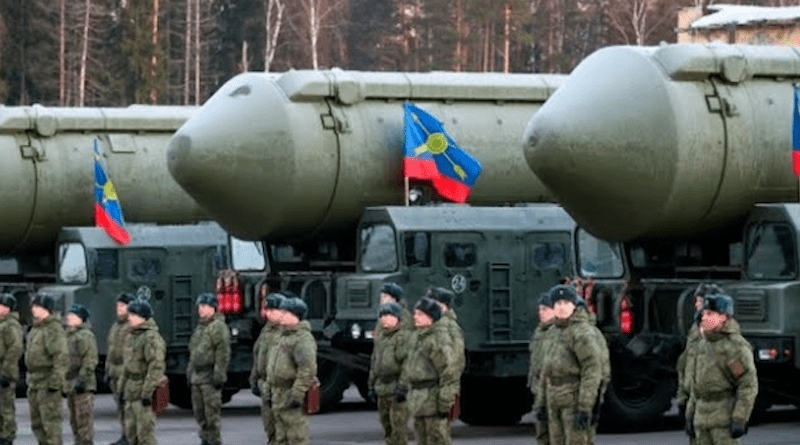
The war between Russia and Ukraine has entered its second year and there is no end in sight. Earlier this month, in a concerning escalation, Russia announced that it plans to hold drills simulating the use of tactical nuclear weapons along the border with Ukraine. Earlier in March, Russia had said that it would station nuclear weapons in Belarus. Such nuclear posturing in the middle of a war is worrying.
Russia cited statements by leaders from countries which are aiding Ukraine in the war as the reason for upping the nuclear ante. It was referring to French President Emmanuel Macron’s statement that he would potentially deploy troops to Ukraine and British Foreign Secretary David Cameron’s remark that Ukraine will be allowed to use British long-range weapons to strike targets inside Russia.
Shift in understanding
However, Russia’s plans appear to be attempts at brinkmanship and coercion rather than responses to actual existential threat. Russia’s claims that Mr. Macron and Mr. Cameron’s comments constitute an existential threat requiring nuclear preparedness are a stretch at best. Neither France nor the U.K. has made moves that genuinely threaten Russia’s survival which would then call for Moscow’s justification for its action.
On the surface, Russia’s sabre-rattling may seem like a predictable move to deter further intervention by Ukraine and its allies. After all, threatening the first use of nuclear weapons for deterrence, that is, to prevent the escalation of conflict or termination of war, is often a tactic used by nuclear powers like North Korea which face threats at their borders from larger adversaries. However, in the latest crisis, Russia is mulling lowering the threshold for the use of nuclear weapons. If this become an accepted norm, it could have huge consequences.
For decades after the Cold War, the logic of nuclear deterrence has been based on certain inviolable understandings. Most important among these is that any nuclear use would inevitably result in destruction in both the countries fighting the war. This principle of deterrence is known as mutually assured destruction. In addition, a country resorted to the nuclear option only in case of an existential threat by an adversary. In the case of Russia and Ukraine, the war is largely destabilising on conventional levels and does not directly jeopardise Russia’s own existence; yet, Russia has shown its willingness to exercise its nuclear option. Moreover, the Russian nuclear doctrine codified nuclear first use only in the most extreme case of threat to its survival. The fact that these long-held nuclear red lines are being stretched and redrawn over the course of a war represents worrying shifts in the core understanding of nuclear deterrence.
By making explicit nuclear threats at lower levels of conflict, Russia is on a dangerous path. If nuclear powers routinely threaten to use nuclear weapons as a coercive tactic when pushed into a corner during a conventional conflict, it may encourage other states to follow suit. This may lead to smaller nuclear-armed nations wondering whether openly brandishing their nuclear might will be enough to undermine the resolve of stronger conventional military opponents. Countries like Iran and North Korea may feel emboldened to cross the nuclear weapons threshold, confident that flaunting their nuclear deterrent will make adversaries back down out of fear of escalation.
Thus, while the odds of any tactical nuclear strike by Russia remain low at present, Moscow’s nuclear signalling sets a dangerous precedent. Nuclear weapons may no longer be weapons of last resort. The clear distinction between nuclear and conventional warfare is gradually being undermined in this war.
There are other dangerous precedents being set too. Russia’s move threatens to undermine already lacklustre and admittedly halfhearted efforts towards non-proliferation of nuclear weapons and disarmament. The ongoing war has exposed the vulnerability of non-nuclear states to aggression from states with nuclear weapons. Russia’s move could potentially motivate other states to pursue nuclear weapons to deter threats.
Ukraine’s decision in the Budapest Memorandum to give up its nuclear arsenal in the 1990s, in exchange for security assurances from Russia, the U.K., and the U.S., now appears ill-advised. Iran’s recent statement regarding revisiting its nuclear doctrine if there are existential threats from Israel is a case in point. While Iran has consistently maintained that it does not intend to develop nuclear weapons, the prospect of shifting its policy in response to perceived existential threats from Israel undermines non-proliferation efforts. Such a move may discourage other smaller nations like North Korea from voluntarily letting go of their nuclear capabilities or pursuing disarmament, fearing a similar fate of nuclear aggression.
The unfolding dynamics have created a new nuclear flash point. By raising the risk by lowering the threshold for the use of nuclear weapons, Russia has changed the understanding of how nuclear deterrence works and redrawn the lines of nuclear deterrence. Simultaneously, its actions illustrate how nuclear weapons provide asymmetric advantages in case of conventional war-fighting. This has thus increased proliferation anxieties for smaller states across the world, especially in regions where there are long-standing tensions between states. If the cloud of nuclear war floats above the battlefield, war could take precedence over deterrence and proliferation over disarmament leading to further nuclear instability.
